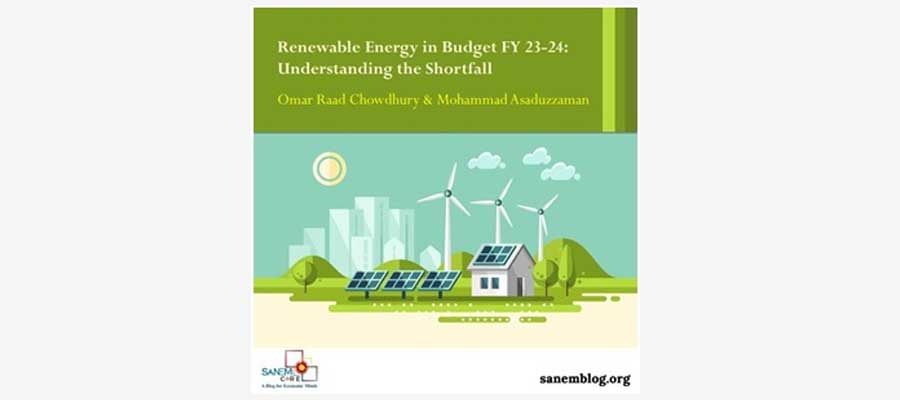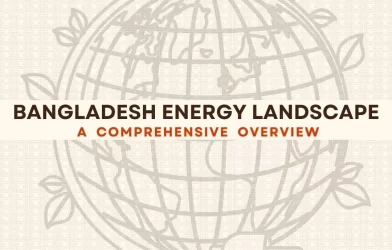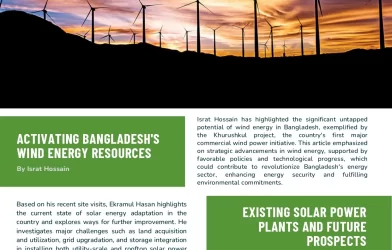Renewable energy in budget FY 23-24: understanding the shortfall
Bangladesh aims to generate 40% electricity from renewable sources by 2041. However, the previous target of producing 10% of total electricity from RE by 2020 is far from being realised. Currently, only 3.7% of the total energy mix consists of renewable sources. To meet the 2041 renewable energy (RE) target, renewable capacity needs to be 16 Gigawatt (GW) in 2031 and 40 GW in 2041.
The Infrastructure Development Company Limited (IDCOL) has provided estimates for the proportion of RE in the power sector under three different scenarios in the “Mujib Climate Prosperity Plan – Decade 2030: Power Sector Analysis”. The scenarios are Mujib Climate Prosperity Plan-Maximal (MCPP-M), Mujib Climate Prosperity Plan-Realistic Scenario (MCPP-R), and Nationally Determined Contributions Scenario (NDC Scenario). According to the estimates, the highest proportion of RE in power generation is expected in MCPP-M (19%), followed by MCPP-R (13%) and NDC (6%).
For each of these scenarios, it is necessary to understand the investment need. The “Mujib Climate Prosperity Plan—Decade 2030: Power Sector Analysis” presents an estimate for 2025 and 2030 for all three scenarios in this regard. The estimate posits that under the scenario of MCPP-M, the investment required by 2025 is BDT 26,675 crore, and by 2030 is BDT 69,664 crore. Under the scenario of MCPP-R, the investment required by 2025 is BDT 21,193 crore, and by 2030 is BDT 44,002 crore. Under the scenario of NDC, the investment required by 2025 is BDT 8,819 crore, and by 2030 is BDT 18,720 crore.
In the recently announced national budget for FY2023-24, BDT 34,819 crore was allocated to the Ministry of Power, Energy and Mineral Resources (MoPEMR)–which is 27% higher than the revised budget for FY 2022-23. Among the BDT 33,825 crore allocation for the Power Division (PD), BDT 33,775 crore is allotted as the development budget. For the Energy and Mineral Resources Division (EMRD), only BDT 994 crore was allotted–which is only 3% of the total allocation for the energy and power sector. Furthermore, compared to the budget of the last financial year, the allocation for EMRD has decreased significantly by 48%.
Reportedly, the national budget FY 2023-24 does not offer any notable special incentives for clean and RE. Currently, 15.25% to 58.6% of import duty is applicable to technologies like rooftop solar, fibre-reinforced polymer walkways, imported inverters, mounting structures, and direct current cables. The budget FY 2023-24, however, has exempted value-added tax (VAT) on up to 60 AMP solar battery production for partner organisations of IDCOL.
A quick look at the budgetary allocation thus reveals the incongruency between stated RE targets in the national plans and the policies undertaken. While the investment needed for accelerating RE adoption will require extensive participation from the private sector, the role of the public sector cannot be neglected. According to the International Energy Agency (IEA), globally, government expenditure on clean energy has risen by $500 billion since the start of the Ukraine crisis–understandably so, in the face of the shocks in the global energy supply. Almost half of these new investments are concentrated in solar PV. However, this trend is led by developed countries. Yet, as a developing country, Bangladesh needs to revamp its commitment to RE. A major strategy in this regard should be an increased level of public investment in clean and RE–for which there is no alternative to shifting the budgetary consideration. Government spending can also be a significant factor in mobilising private investment in the RE sector.
There are, however, some concerns regarding public investment in RE. The dominating view is that policymakers should refrain from picking market winners by investing in certain firms and technologies, as such practice has the potential to distort the market structure. Another crucial concern is that government subsidy for RE can encourage rent-seeking behaviour among certain stakeholders.
Nevertheless, there are some strong arguments for public investment. Firstly, the private sector may fail to consider investment in RE as profitable, given the abundance of knowledge on conventional fossil-fuel-based technologies and market structure. Public investment, on the other hand, can overcome this barrier. Moreover, the government has much greater scope in bearing the associated risks and the high initial cost of capital, with a view to generating greater economic and social returns in the long term. It goes without saying though, that the government needs to follow a system with defined rules so that no certain groups with special favours emerge as the winners.
The need for subsidising RE and technology becomes apparent in a similar context of social interest and inherent market dynamics. Economist Dani Rodrik, Ford Foundation Professor of International Political Economy at the John F. Kennedy School of Government at Harvard University, in his paper on green industrial policy argues that subsidies on fossil fuel and failure to implement appropriate taxes for managing climate risks mean that for the private sector, return to green technologies is well below the societal returns. To make the best out of such subsidy programs, within a broader framework of an industrial policy, Dr Rodrik argues that the government should pursue strategic collaboration with the private sector so that bottlenecks can be identified and done away with. He also maintains that through accountability and effective discipline, rent-seeking behaviour can be managed.
As far as economic and social benefits go, it is imperative that Bangladesh strongly pursues the RE pathway. To achieve the government’s stated goals of adopting RE and upholding its climate commitments, there is no alternative to prudent management of budgetary tools and fiscal space.












